Khasis-tro
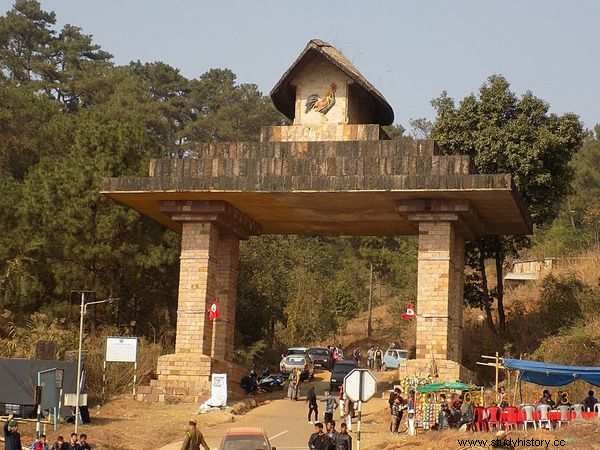
Indigenous people in the state of Meghalaya and with a significant population spread across Assam and Bangladesh, there is an ethnic group called Khasis. They make up 48% of Meghalaya's population, and are truly a unique tribe.
Khasis believes in an extensive mythology that traces their roots to Ki Hynniewtrep or the seven huts. According to this, humanity in sixteen heavenly families of God or Lord Master (Khasis calls their God as U Blei Trai Kynrad). However, only nine of these sixteen families were sent up to heaven while the other seven remained on earth. Myth says that there was a celestial ladder or a golden tree on the top of Lum Sohpetbneng that gave families free access to heaven. Their journey back and forth from heaven remained uninterrupted until mankind was destroyed by sin. On a fateful day, people were tricked into chopping down the sacred tree, thus closing the gates of heaven for them, never to open again.
Khasis' fervent belief in this legend leads them to regard trees and nature as God's manifestation on earth. According to them, cutting down trees and harming nature is a sin that cuts their relationship with their God. To this day, the Lum Sohpetbneng peak is a sacred site for Khasis. On the first Sunday of each February, an annual pilgrimage is made to the summit to perform traditional dances, songs, rituals and rituals.
Religion
In early times and until today, Khasis considers nature as a part of God, and therefore also worships the pagan gods. Khasis also considers the rooster to be a figure of worship, because it was the rooster that moved God with prayers to create the universe in the first place. While Khasis did not worship his ancestors, they respected them and treated them as mediators and elders.
Before the advent of Western influence and Christianity, Khasis followed its own indigenous people, which consisted of ka niam-im, which are the rituals of life, and ka niam-iap, the rituals of the dead. Ka niamim concerns the current life of the living members. The members follow a peaceful way of life to ensure their entry into life after death and thus be blessed with immortality. Ka niam-iap includes rituals and rituals performed at the departure of an earthly soul for a simple transition, until they have entered the heavenly kingdom. At the death of a member of the clan, their bones are safely stored in a mawbah. A mawbah is a sacred stone for the dead, used as a storage place for the bones. It is believed to be a symbol of the dead person's entrance to the next kingdom. The ritual of depositing the bones of the person is of utmost importance, because if it is not done, the deceased soul would never rest as they are not able to meet the mother of the ancestor in the spiritual realm.
Today, belief in ka niam-im and ka niam-iap has been significantly reduced due to various reasons. The practitioners of the religion themselves rejected many rituals to keep up with changing times and circumstances. Western influence is another important cause.
The arrival of Christian missionaries affected the clan in important ways. Today, most of Khasi's Christianity, of which the main denominations are Catholicism, Anglicanism and Presbyterianism (which is the largest among Khasis.) As a result of interfaith marriage, Islam also prevails in the clan. One of the many positive aspects of the Khasi lifestyle is that no single religion is imposed on its members. They are free to choose which deity or God they want to believe in.
It is believed that Khasis had no original script or language. They spoke Bengali until the British arrived.
Traditional dress
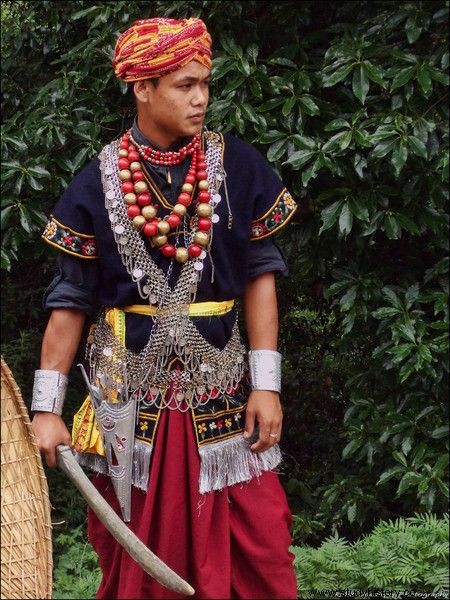
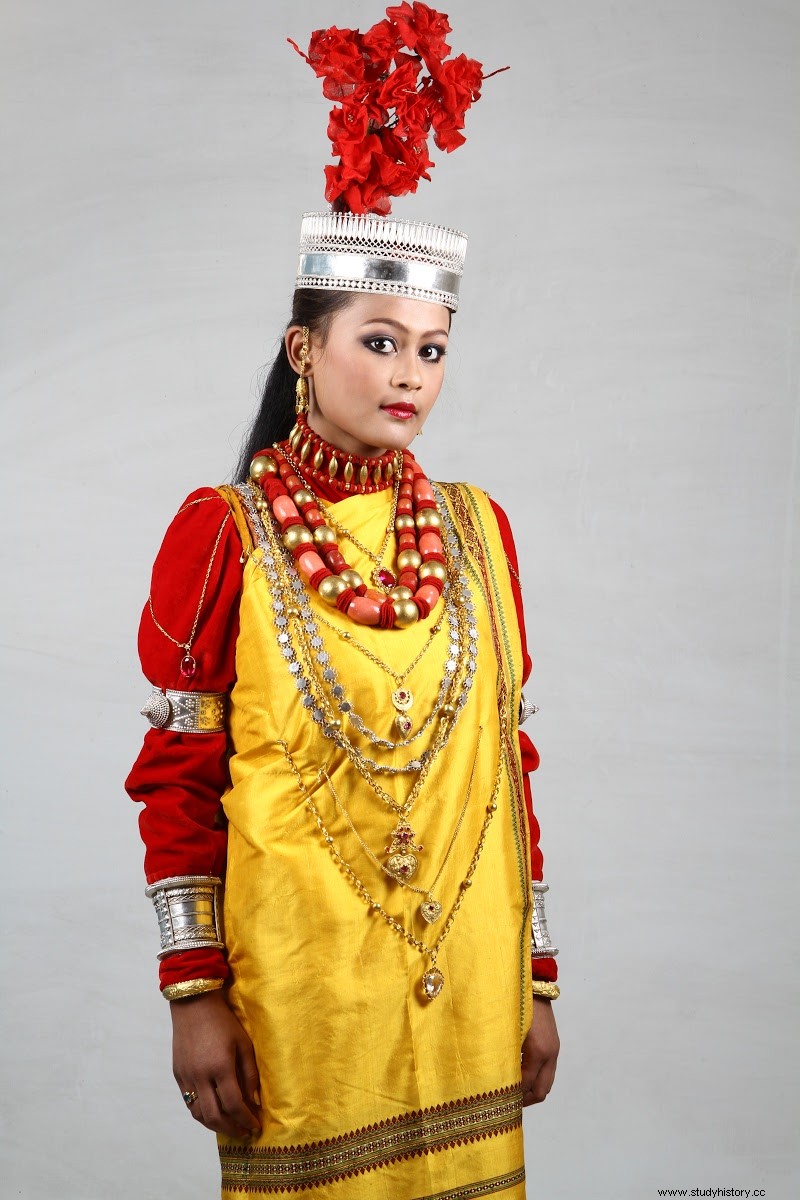
The men wear the traditional dress called Jymphong. A Jymphong is a long sleeveless coat that does not have a collar. It is held in place with things in front. In our time, one can see the influence of the West on the way to dress. Most men in the clan have taken up western clothes. During events such as ceremonies, festivals and rituals, they wear the Jymphong, along with a sarong and a turban. An ornamental waistband is wrapped around the waist.
For women, the traditional dress is Jainsem or Dhara. The former has two pieces of material attached to each of the shoulders, while the latter has one piece of material attached to each shoulder. Both of these clothes are very elaborate, consisting of many layers and pieces of cloth. When dressed up in these, the body attains a rather cylindrical shape. As the men wear the turban during ceremonies and festivities, the women wear a crown made of silver or gold. On the back of the crown there is a spike, which corresponds to the colorful feathers that the men wear.
The dancers during festivities wear even more elaborate clothes. Female dancers are draped from the waist to the ankle in a cloth called Ka Jingpim Shad. A blouse with intricate lace at the neck and long sleeves called Ka Sopti Mukmor is worn. Ornaments include a necklace (U Kpieng Paila, consisting of red coral and pearls), a silver necklace (U Kynjiri Tabah), gold earrings (Ki Sohshkor Ksier), large silver bracelets (Ki Mahu) for both arms and gold bracelets (Kikhadu Ne Ki Syngkha). The cloth pieces attached to the shoulder, called Ka Dhara Rong Ksiar, are of rectangular shape, embroidered with gold thread. The crown is decorated with fresh flowers.
The male dancers are adorned in a golden silk flower (Ka Jain spong Khor) with a large feather. A jacket heavily embroidered and without sleeves (Ka Jympang) is worn. The shoulders are adorned with a silver chain (U Taban). An arrow tree made of silver and an animal tail hang from the waist. Dhoti is a reddish-brown silk cloth. The men also carry a ceremonial sword.
festivals
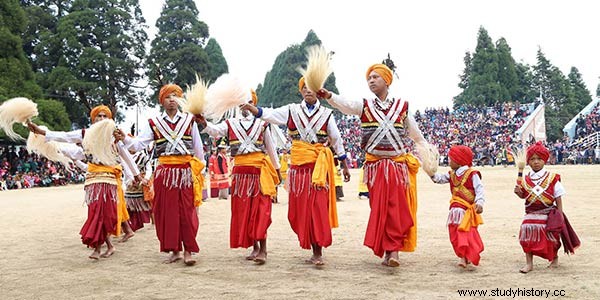
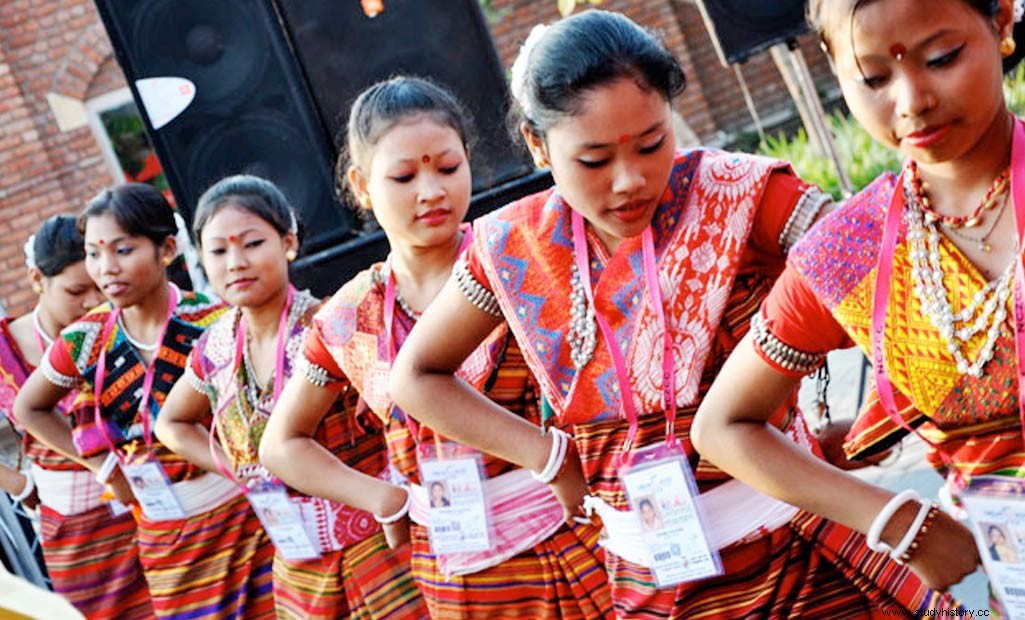
Dance and music are an important part of any Khasi festival. The music is strongly influenced by nature - they are filled with natural sounds such as bird calls, the hum of bees, the cries of wild animals and the sound of a flowing river. Music also celebrates tribal and ancestral legends. Among the many forms of music are phawar (a basic form of music, a song), ballads and verses. Phawar is a song composed improvised for the occasion. The ballads and verses tell the stories of martyrs, legendary heroes and battles. Musical instruments include drums and flutes.
One of the most prominent of the Khasi festivals is the Festival of Dance. Dance is part of the 'rites de passage', which can either be a celebration of a member's life cycle or just for the annual season. While dance is rooted in the heart and soul of the entire clan, each area or subdivision of the clan adds its own variations in shape and color.
The different types of dance festivals are
- Ka Shad Suk Mynsiem: An annual spring dance performed to celebrate agriculture and harvesting and sowing. Female dancers must be virgins while men do not have such restrictions.
- Ka Pom-Blang Nongkrem: A five-day festival celebrated in gratitude to God for a great harvest. Those who participate pray for the prosperity and peace of the clan. It is one of the oldest dance festivals in Khasis. The ancestors are also offered to bless the community with a good harvest.
- Ka-Shad Shyngwiang-Thangiap: This ceremonial dance is performed when a death occurs in the clan. It is an expression of grief. Drums and flutes are played by male musicians. The dance begins on the day of death, and it is performed near the kitchen in the house. The dance ends when the last rituals are performed.
- Ka-Shad-Kynjoh Khaskain: A dance to celebrate the influence of a family. The dance is performed after the ceremonial rituals have been performed. It continues into the night and ends at dawn. Although dancers perform in a group, each dancer has an individual rhythm and footwork. The dance is filled with playfulness and joy. Unlike the other dances, there is no need for formal attire.
- Ka Bam Khana Shnong: A gathering of members filled with dancing to thank their God for the past year and to pray for a blessed new year. Each home would contribute some kind of food or agricultural products. The parties mostly consist of different pork dishes. The pigs are brought in decorated pony carriages accompanied by musicians with drums and whistles.
- Umsan Nongkharai: An elaborate five-day festival made of animal sacrifices, dancing and prayers. It is a ritual performed to bless the community with contact with the heavenly souls. Prayers are offered to protect members from natural disasters and to be blessed with prosperity and fertility. Men carrying drums and whistles perform music and dance.
- Shad Beh Sier: A dance ritual in the autumn season to celebrate deer hunting. Every deer that is hunted is celebrated with dance and merry production. The hunted deer is the parade around the villages while the rest of the villagers cheer on them.
Marriage and Divorce
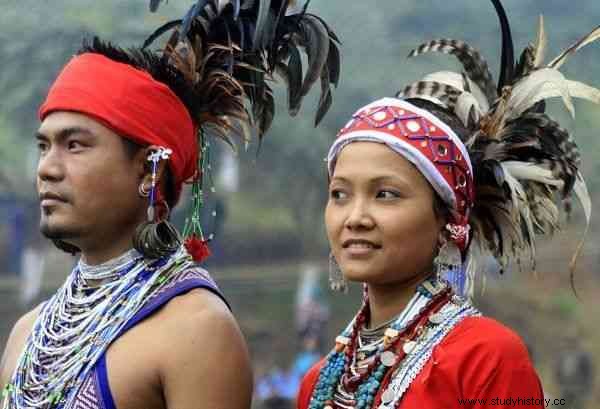
When it comes to marriage, men and women are free to choose partners. Potential partners get to know each other before they get engaged. The men report the choice of partner to the parents who then seek mediation to consult the woman's family. The woman has the right to accept or reject the suitor. If the woman agrees, the family makes sure that the man is not already married. If all goes well, the wedding is resolved. Getting married in your own clan is unacceptable. During the association, the couple exchanges either rings or betel nut bags.
If the man is married to an heir (Ka Khadduh), he moves into the mother - in - law's house. If the woman is not the heir, the couple lives independently, away from both families. Most men prefer to marry a non-heir as this will give them the freedom to live independently of their in-laws.
Divorce can be achieved for many reasons, ranging from lack of children, adultery and incompatibility. The traditional divorce ceremony consists of the couple giving 5 paisa to each other. These are then either thrown by themselves or given to an elder in the village to be thrown. Today, divorce is practiced through the Indian legal system.
Matrilineal Society
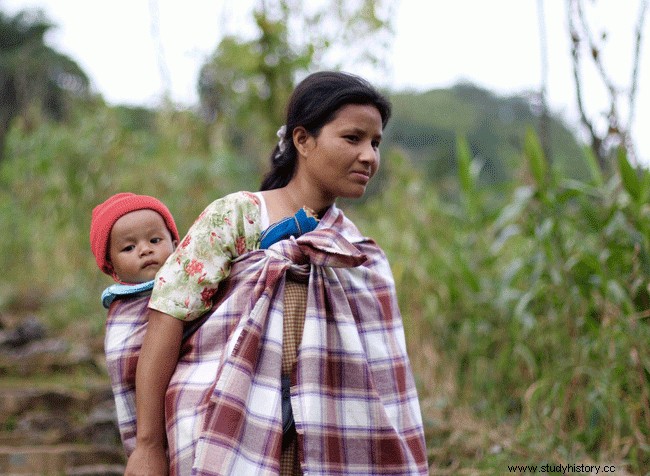
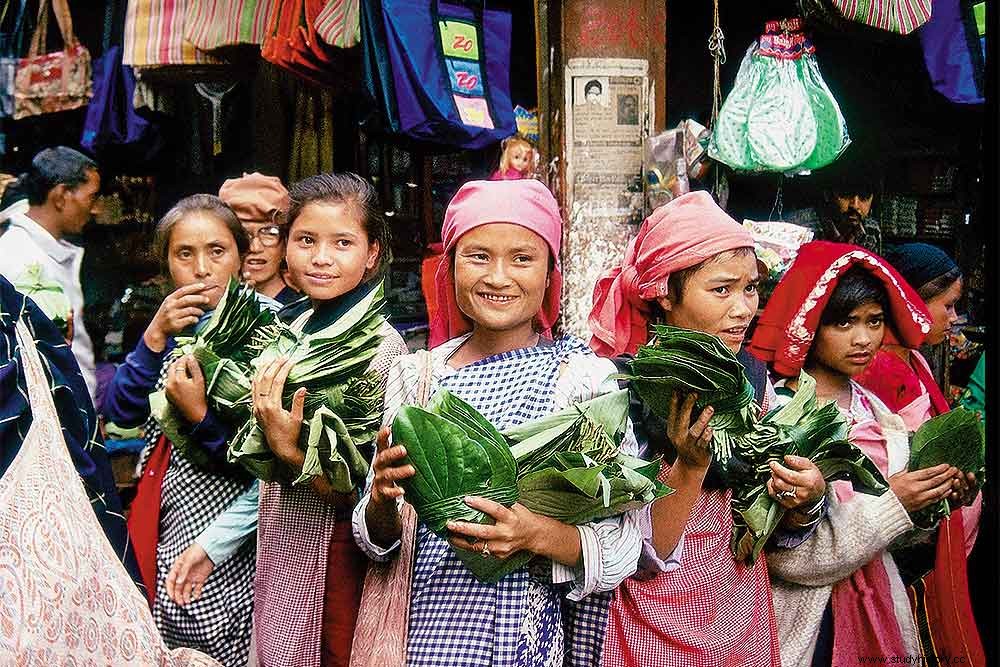
Undoubtedly, the best thing about Khasis is that it is a matrilineal society. Unlike the rest of the country, women have a dominant role here. In a family, it is the youngest daughter (Ka Khadduh) who inherits all the property. The man moves into the mother - in - law's house after the marriage. If the couple has children, they take on the mother's surname instead of the father's. If the couple has no daughters, they adopt one and all the property is given to her. While the birth of a son is simply recognized, the daughter is celebrated with great pomp. A woman is not subjected to criticism or stigma for having children out of wedlock or remarrying. They are allowed to marry outside their own tribe. Sex before marriage is accepted, but infidelity is a criminal act. The woman can also choose to remain unmarried as well. Most businesses are owned and managed by women. The mother or mother-in-law takes care of the children. The woman who inherits the property has the role of taking care of the parents and siblings.
With many unconventional lifestyles, Khasis is a race unto itself. The treatment of women is definitely something that the whole country can learn from.
